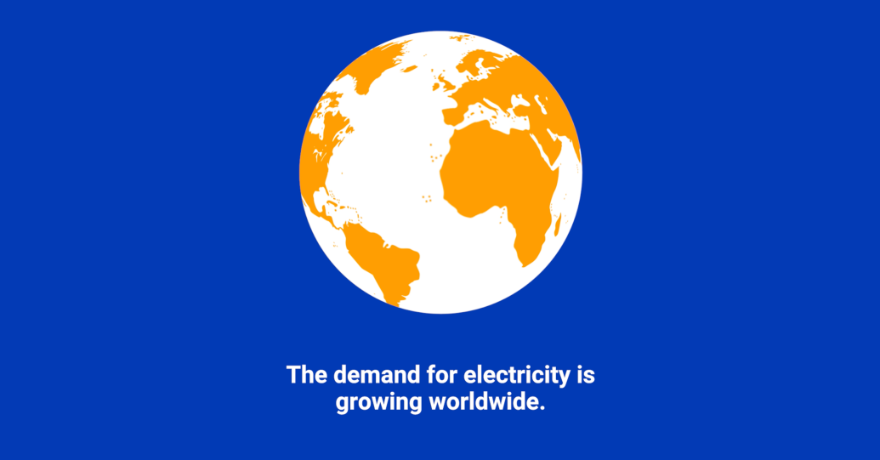Earth Day Sustainability
When was the last time you thought about what happens when you turn on a light switch?
Quite often, we take for granted the infrastructure that supports every light we see with and every appliance we operate.
As the demand for electricity continues to grow with the population, it’s important that the power grid can meet this demand in not only in a sustainable but socially responsible manner. As a critical component of modern society, the way we generate and distribute electricity has significant environmental and social impacts, and it is important to consider these impacts as we work to meet the growing demand for electricity.
In the past century, the power grid grew significantly. This growth has been a result of the increasing demand for electricity in both homes and businesses; and access to electricity worldwide is now considered a basic necessity. The percentage of the global population with access to electricity has risen dramatically: in 1990, just over 76% of the global population had access to electricity. By 2019, this number had increased to over 90%. According to data from the International Energy Agency (IEA), the total global installed capacity more than tripled from 1990 to 2019, reaching almost 25,000 gigawatts (GW).
With this rapid increase electrical grid size, the sustainability of our energy sources because increasingly important. A larger grid with more demand equates to more pollutants, unless we insist on shifting to renewable energy sources. Globally, the effort to transition to renewables has been driven by a variety of factors, including:
Concerns about climate change
Clean energy is more readily accessible
Rapidly falling cost of renewable energy technologies
Government incentives to promote the use of clean energy
In 2019, renewables accounted for almost 25% of total global electricity generation, up from just over 6% in 1990.
It's also important to consider the social responsibility of the rapidly scaling power grid. This includes ensuring that all communities have access to reliable and affordable electricity, as well as protecting them from the negative impacts of power generation, such as air and water pollution. In many cases, underserved and marginalized communities bear a disproportionate burden of the negative impacts of power generation. Some racial and ethnic groups are among those who often face higher exposure to pollutants, and studies have explored the differences in harm from air pollution to racial or ethnic groups and people who are in a low socioeconomic position, have less education, or live nearer to major sources of pollution.
These marginalized groups could be susceptible to a higher exposure to pollution for a variety of reasons including:
- Racism
- Class bias
- Housing market dynamics (linked to location and socioeconomic status)
- Land availability and development costs
Pollution sources tend to be located near disadvantaged communities, increasing their exposure to pollutants. Lack of access to proper health care and quality grocery stores, poorer job opportunities, dirtier workplaces, and more exposure to traffic further handicap these groups and increase the potential risk of harm. These demographics also have higher Pre-existing and untreated medical conditions which increases their risk.
One of the challenges facing our growing civilization is the need to balance this increasing demand for electricity with the need to reduce greenhouse gas emissions and combat climate change, especially for the communities who may bear the greater burdens of pollution. Fossil fuels, such as coal and natural gas, are still currently the primary sources of electricity in many developing parts of the world even though they contribute to climate change and have notable negative impacts on public health.
To offset these effects, many countries are turning to a mix of renewable energy sources and more efficient technologies to power the electrical grid. Many countries are investing in renewable energy infrastructure, including:
- Large-scale solar arrays
- Wind farms
- Update clean nuclear technology
- Hydroelectric power
Automotive pollution continues to be a significant source of greenhouse gases, and their pollutants affect all individuals equally, so a switch to electric vehicles has the potential to significantly reduce our reliance on fossil fuels and decrease harmful emissions. With an emphasis on EV charging provided by electricity from renewable energy sources, this can also result in a significant positive impact. Alongside the obvious environmental benefits, electric cars are also cheaper to operate and require less maintenance than traditional gasoline-powered vehicles.
In the United States, Electric vehicles currently only make up for 1% of the 250 million vehicles on the road since the upfront cost of purchasing an electric car remains much higher than a traditional gasoline-powered car, and the availability of charging infrastructure is still not as widespread as the network of gas stations. To help with more universal adoption of EVs, governments offer incentives like tax credits and rebates, and more homeowners are installing charging stations in their garages.
Despite the challenges, the transition to electric vehicles is an important step towards a more sustainable future, and the environmental and economic benefits of EVs make them a compelling choice for many consumers. In addition to electric vehicles, many small motor manufacturers have switched to electric battery-operated options as well. Lawnmowers, leaf blowers, and other garden and landscape equipment are now available in cleaner, more energy-efficient options that have taken the place of their gas-operated counterparts.
We can all work for sustainable energy that will protect our future, starting with supporting the development and deployment of clean energy sources, such as solar and wind power. We can do our part in several ways:
- Lobby for clean energy focused policies
- Invest in clean energy projects
- Purchase clean energy options for your home or business
- Buy battery-operated equipment when possible
- Consider an EV purchase
- Adopt infrastructure options for the home (solar, EV charging, batteries)
Advocating for policies that prioritize sustainability and social responsibility in the power grid is critical, as it will result in broader awareness and more widespread adoption of renewables. With more renewable energy incentives and improved regulations on air and water pollution, we can support the ongoing adoption of clean energy and advocate for policies that prioritize sustainability and social responsibility. We can vote with our dollar by purchasing energy from providers who utilize sustainable generation, buying battery-powered lawn and garden equipment, investing in a solar array and battery infrastructure for the home, and consider an EV purchase when financially possible.
The growth of a sustainable and socially responsible power grid is essential for addressing climate change, protecting public health, and ensuring that all communities have access to reliable and affordable electricity. By supporting clean energy, investing in new technology and infrastructure, and advocating for policies that prioritize sustainability and social responsibility, we can ensure that all our communities and the Earth will continue to thrive.








